Abstract
Building Information Modelling (BIM) is modifying the workflow of the construction field, not only in design and construction stages but also for the management of the facilities. Most advances in academics and industry have focussed on the use of BIM for building. However, the possibilities of the use of three-dimensional information models for the construction and management of public works and civil engineering infrastructure projects (known as CIM) are still a matter of concern, being complex though offering a wider number of possibilities when compared with regular building industry. Moreover, the construction process in comparison with its lifespan represent only a small part of the investments for the use of public works. With this background, the possibilities based on BIM for the maintenance and rehabilitation of public heritage (HCIM) can greatly improve traditional management capabilities. Making best use of BIM and digitalisation for the management of public heritage (HCIM) requires creating tools for documentation, registering and data management to permit the adequate information transfer between the actors involved. Such actors may be experts or not and hold or not skills to use BIM tools. This study proposes the creation of a database to support the regular inspection during the lifespan of the infrastructure and connect it with the three-dimensional information model, serving the latter as an information repository of the whole life of the infrastructure. Such data include damage and causes as well as a description of the pathology and this information is referred to each element, showing all the historic measures taken. In addition, quantification and quotation of the repairs needed can be obtained. Lastly, the study has applied this methodology in Algeciras Market Hall, the notorious rationalist building designed by the engineer Eduardo Torroja and built in 1935. The results shown in this study can be of great interest for both researchers and practice, with an adaptation and innovation of the BIM and HCIM possibilities.
1. Introduction
The construction sector boasts various particularities that have undermined the modernisation of the procedures. Even two identical projects would not be performed similarly by two companies or varying location, climatic conditions, soils, labour education or machinery available. It must also be considered that the costs associated with the project phase involve a minimum percentage of the overall investments in public works, ranging from 2% to 5%, while the project implies a great influence on the quality regarding the quality but also the future costs of maintenance and exploitation of the public works. Thus, the objective must not centre on reducing the project costs but the overall costs in the lifespan of the infrastructure, costs of construction, maintenance, exploitation and dismantling. Furthermore, costs must be considered in a wider sense, considering social, environmental and economic aspects of the investment. In this context, BIM-based (Building Information Modelling) strategies are promising, since the collaborative and multidisciplinary workflow has shown its potential by using three-dimensional information models and considering the complete life cycle [1]. BIM methodology is applied for the maintenance and operation of the infrastructure, is commonly known as BIM-Facility Management and is based on the three-dimensional information model generated at the end of the construction process [2]. For this, it is essential that design and modelling phases are performed following certain standards and with a three-dimensional information model having the appropriate information, which allows the transfer of data from one phase to another. Public heritage usually incorporates modern technologies into the field of design and construction. The technical complexity and size of the infrastructure together with their interdisciplinary nature make it necessary to integrate strategies that allow sustainable asset management [3]. In addition, when it comes to maintenance operations in public heritage, exclusive functions of the administration are usually mixed with others, and these are usually carried out by a specialised contractor [4]. A maintenance strategy is essential in order to guarantee the operation quality during its lifespan. The main aim of such strategy is to extend its lifespan, avoiding the premature ageing due to environmental or mechanical factors. Preventive maintenance could be considered the most effective preservation approach in contrast to traditional curative conservation strategies [5]. This strategy can save more than 50% of the total maintenance cost if the cause of damage is addressed directly, minimising the risk of chemical and physical degradation processes. In the context of built environment, cultural heritage is commonly named as HBIM (Historic Building Information Modelling) and is being usually focused on the digitization of historic assets as in libraries [6]. Published literature [7,8,9] has shown a diagnosis of the construction with an assessment of each element of the building, generating a three-dimensional information model. This would make it possible to develop a proposal for intervention—what could be incorporated in the “as built” model that include future preventive maintenance.
However, preventive maintenance in civil engineering structures such as bridges, dams or other specific structures that are commonly designed by engineers require specialized knowledge [10,11,12]. Such BIM-based management of public heritage (HCIM) entails techniques different to the conventional use of HBIM in buildings [13,14]. This requires a specific methodology that can provide an adequate solution from the point of view of engineering that develops objective criteria for the structure conservation [15,16]. The three-dimensional information model generated should include aspects such as construction system, materials, existing damage or maintenance cost with a standardised and integrated protocol to document and manage all the information needed to preserve the infrastructure. Moreover, according to the Agenda 2030 and the Sustainable Development Goals of United Nations, environmental impact studies as well as their integration in the public tender processes are claimed for a more participative society. Submission to community law as a member country of the EU together with recourse to European funds for investment financing are some of the aspects that modern public works management must face, which makes it necessary for the administration to have the best means available.
In this context of BIM-based management of public heritage, HCIM can be separated into five different phases:
- Phase I (Documentation) concerning the study and collection of evidence which concludes on the elaboration of an inventory concerning all the historical information. It should also include record of the actions and intervention made so far of each of the elements as well as its state of deterioration.
- Phase II (Diagnosis) regarding the 3D digitalisation of the infrastructure with an analysis and assessment of the conditions of the complete infrastructure.
- Phase III (Control) encompassing identification, categorisation and classification of the damage observed in Phase II. A specific map of damages (damage associated with its location) will be elaborated based on the information obtained in Phase I. It allows to qualify objectively its complete conservation status.
- Phase IV (Prognosis) involving the determination of the intervention thresholds for the next phase. When any damage is serious enough, proposals can be made to correct the situation in a prioritised way since all the information on the state of the infrastructure is available.
- Phase V (Therapy) aiming to anticipate and forecast the process of deterioration of the structure.
For public heritage infrastructure, HCIM could entail a great number of advantages. Since BIM methodology is mainly oriented to new construction, including this new standard of documentation, diagnosis, control, prognosis and therapy for the public heritage would be needed in order to develop the methodology. More specifically, at the time of preparation of the map of damages, where it must include the documentation in the three-dimensional information model to allow a more in-depth analysis of the infrastructure. For HBIM, there is a computer application intended for building called Plus Care. However, even Plus Care is a very valid Web-GIS application, though it has relevant limitations when applied to infrastructure.
In this study, HCIM methodology is proposed and incorporated to public heritage management, taking as a case study the Algeciras Market Hall, following heritage care’s preventive conservation good practice guidelines [17] but without the need to use an external application. A three-dimensional information model has been made, with the appropriate information relative to the infrastructure, to automatically generate a database from the documentation available that include an inventory with detailed information on damages, historical records, inspections, etc. The database of the infrastructure would also enable the preventive conservation in the future, with automatic generation of technical data and inspection report, if necessary.
2. Materials and Methods
The proposed HCIM will be based on five interconnected steps (Figure 1). To that end, the following steps were followed: (i) the collection of data regarding the geometric, structural and maintenance of the infrastructure in a database by using a conventional worksheet; (ii) the 3D digitalisation of the infrastructure by using Autodesk Revit and Autodesk Inventor; (iii) an HCIM model that manages the information derived from the previous steps and the information related to the future regular inspection through use of Dynamo.
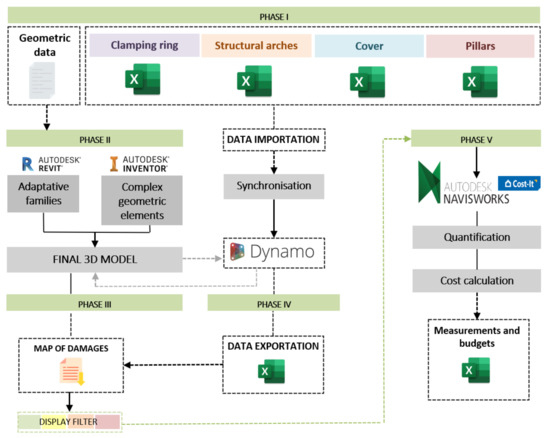
Figure 1.
BIM methodology applied to public heritage infrastructures (HCIM).
HCIM has been mainly oriented to geometric and structural data regarding the state of conservation, with the data supplied by local authorities.
3. Case Study: Algeciras Market Hall by the Engineer Eduardo Torroja
3.1. Phase I
Eduardo Torroja was one of the most notable structural engineers of the 20th century. He was a prominent researcher, designer, scientist and professor, pioneering the use of reinforced concrete structures, especially in laminar structures. Currently, his research and contributions on the behaviour of reinforced and prestressed concrete are internationally acknowledged as well as subject matter to publications, conferences and research projects around the world.
Algeciras Market Hall is also known as Engineer Torroja Market. Built in 1935, it is one of the most telling examples of Torroja’s structural philosophy. The simplicity is integrated over complexity, gathering both technical and art features as well as a deep understanding of the functional aspects. Algeciras is a port city in the Bay of Gibraltar, in southern Spain, whose most important resources until the first half of the 20th century were the agriculture and fishing industries. The objective of the project was to cover the open-air market with a large open space, absent of interior supports. It was built in the form of an octagon with four streets by defining the contours. The dome was the largest in the history for 30 years (1935–1965) and the structural concepts implied a step forward in the construction of domes [18]. As a result, it was declared an asset of cultural interest by the Regional Government of Andalusia in 2001 as the best example of the Modernist Movement.
Hence, the essential and main element in the structure is the dome. It is a spherical and thin layer cap of reinforced concrete of 47.76 m span between supports with a thickness of only 10 cm, growing to 50 cm in the eight supports. The support columns are connected with a prestressed ring, forming an octagonal floor plan. The lateral cylindrical vaults together with the supports represent the fundamental elements in the infrastructure. Such supports can be found in the eight vertices of the intersection between the vaults and the dome. The pillars, together with the prestressed ring, absorb horizontal and vertical forces transmitted by the dome. For a better comprehension of the description, see Figure 2.
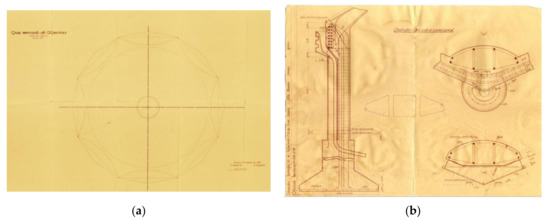
Figure 2.
Original construction plans of the Archives and Records Management Unit ETM-093-001. Algeciras Market Hall (Record 158) in Torroja’s archive: (a) Roof floor. No. 158.208 (scale 1:100); (b) Main support detail. No. 158.218 (scales 1:1 and 1:5). [Available in: http://www.cehopu.cedex.es/etm/expt/ETM-093-001.htm (accessed on 9 December 2021)].
The structure was in service without the need for any noticeable maintenance work until 1996. At that year, Algeciras Market Hall tendered a rehabilitation project approach to solve noticeable corrosion problems as we can see in Figure 3. The intervention was the result of several inspections that found rust spots and damage in concrete due to the corrosion. The most relevant problems were found in dome, clamping ring and supports. So, the most important rehabilitation works were performed on such elements since they are critical to avoid the collapse of the structure.
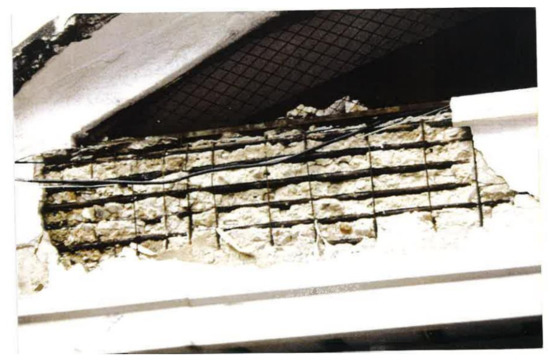
Figure 3.
Photo documentation of the proposed intervention project in Algeciras Market Hall by José A. Torroja Cavanillas. [Available in: http://e-ache.com/modules/ache/ficheros/Realizaciones/Obra14.pdf (accessed on 9 December 2021)].
3.2. Phase II
To perform the 3D model of the Algeciras Market Hall, various data sources were used. The documentary unit ETM-093-001 available on the official website of the Center for Studies and Experimentation of Public Works (CEDEX), which includes original documents such as memory or plans. Updated plans were provided by the Algeciras City Council, as well as photographs carried out in situ. This project is not intended to present a detailed model of the architectural design with a high level of development (LOD). The model was focused on the definition of the relevant structural and architectural elements of the infrastructure by allocating the pertinent properties required for the preventive conservation application in the infrastructure.
In order to make possible to differentiate between the maintenance repairs and the modifications that have been performed, it was highly desirable to use the specific parameter ‘phase filter’. This parameter assigned to the corresponding phase the elements of the infrastructure with the data related to its demolition, modification or new construction. It is equally important to mention the lack of data regarding the materials used in the structure, with the exception of the characteristics of the concrete that have been extracted from the intervention project. Thus, the database of the elements has been deducted from the time of construction, such as the steel yield stress.
To carry out the elements of the model, it is inevitable to work with parametric families due to the complex geometry of some elements as clamping ring, structural arches and with particular attention to the dome (Figure 4). Additionally, it must be considered that for the correct definition of the shape of these elements, it was required to create auxiliary cutting elements with complex empty shapes. For the dome, an in-situ component of the eighteenth part of the dome and the vault was created, and by means of the sweep function, it has been materialised by symmetry.
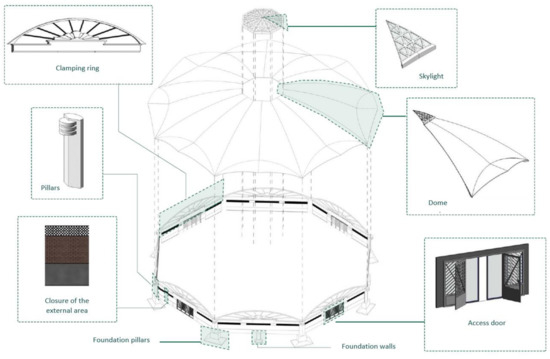
Figure 4.
Exploded axonometric view of infrastructure elements.
Once all the infrastructure elements had been defined, the model was generated (Figure 5) with the use of the available Revit editing tools.
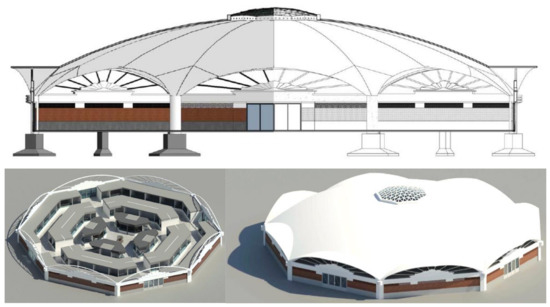
Figure 5.
Profile and isometric view of the exterior and interior of the current Algeciras Market Hall (current phase).
The main added value of this project to the BIM methodology is the incorporation of the data related to damage and pathologies of the structure to the 3D model. To inventory the possible damages and pathologies, not having specific or official manuals as those available for railway bridges from the Railway Infrastructure Administrator (ADIF), a methodological guide for the technical inspection of buildings has been used [19]. It is important to point out that the main objective is not the assessment of the current state of the market but rather the implementation of the BIM methodology to the process of conservation of public works heritage. Consequently, the data of the construction repair project have been used for the example of application of the Great Market of Algeciras of 1997.
The most valuable damages that led to the execution of the aforementioned project in 1997 were found in four areas: the perimeter clamping ring, the structural arches of the vaults, dome and pillars. In all of them, corrosion of the steel reinforcement in the external areas as well as some spalling was found, being more pronounced in those elements oriented towards the coast as can be expected. Isolated rust spots were also observed inside the dome, cracks in the non-supporting section at the head of the pillars and on some of the upper faces of the clamping ring, and small damage in the concrete base of the walls.
In the inspections, design errors or non-considered structural behaviour were discarded since no cracks of this nature were detected that justify the corrosion of the reinforcements. Therefore, the damages found were due exclusively to its exposure to the maritime environment. The carbonation of the concrete by the sea salts and the high content of chlorides led to the corrosion of the reinforcements, whose expansive force caused the cracking and loss of the coating, accelerating the process. So, the mechanical characteristics of concrete and steel were considered sufficient for the stresses of the structure, but insufficient for the protection capacity and durability.
The consequences of the damage found in the dome did not pose real risk of structural failure in a short to medium term, but in the long term, it proved to be considerably more dangerous if none were carried out with any intervention, as the tensile failure of the perimeter clamping ring would cause the cover collapse without prior notice. Table 1 shows the variables to be entered in the file in relation to the four groups of families (perimeter clamping ring, structural arches, dome and pillars).

Table 1.
Examples of damages in the perimeter clamping ring to the catalogue.
3.3. Phase III
In the incorporation of the information into the 3D model regarding inspections and other conservation data, it is necessary, after cataloguing the damage, to generate a database that allows importing accurately. The database starts from a worksheet file that contains different fields (Table 2) adapted to each family group. This will facilitate its programming in Dynamo and will include the following information:

Table 2.
Worksheet example of one element for data transfer into the 3D model.
- Damage codification, to identify in the 3D model, using the following structure: three initials in reference to the group of family: perimeter clamping ring (PR), structural arches (ES and AP), cover (VN and AP) and pillars (PL), category and damage. For example, “VN_DUR_EFL” to the efflorescence found in the cover by durability;
- Category;
- Damage;
- Level of damage: The value 0 is assigned when the element does not include any damage; 1 to light damage; 2 to grave and 3 to major damage;
- Severity: light (L), grave (G) and major damage (MG);
- Associate repairs according to the values of damage and severity;
- Observations: comments and suggestions it may consider relevant;
- Picture of damage;
- Measurements: with the partner unit of damage (unit, volume, length or area);
- Repair cost.
A technical data and inspection report sheet can be generated that summarises all the data entered to the 3D model for each element (Figure 6), including a global measure of the damage.
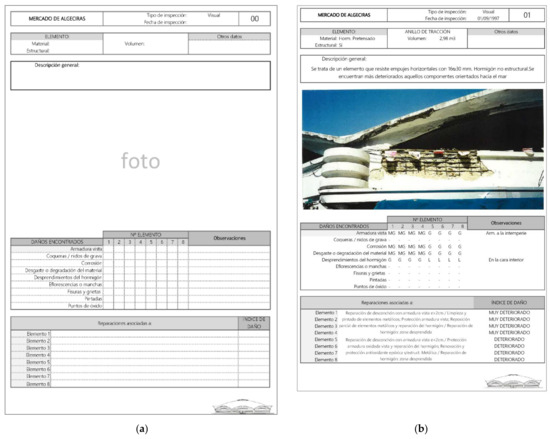
Figure 6.
(a) Technical data sheet with the inspection report to each element; (b) An example application.
For proper external data transfer, it was required to create the parameters in the 3D model associated to the four groups of families. Thus, the coded information of the worksheet was entered in the 3D model by Dynamo and can be consulted in the properties of the element within the 3D model. As can be seen in Figure 7, three classes of common discipline project parameters are distinguished in Revit: text (severity and rate of damage, observations and repairs), numbers (measurement and cost) and images.
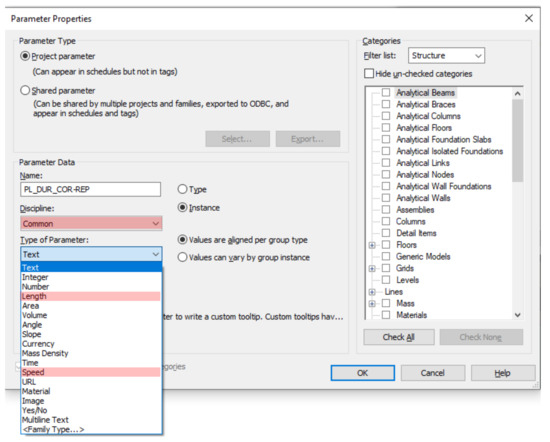
Figure 7.
Example of new project parameter “PL_DUR_COR-REP”.
These parameters can also be associated with established color patterns to display the element and its damage as a resemblance of the traffic light colors (Figure 8). This will modify the visibility patterns associated with the 3D view of the damage map based on the level of damage in the technical sheet, obtaining a quick visualisation of the overall state of the structure [20].
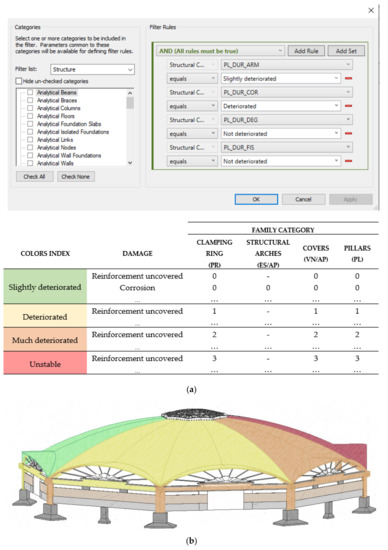
Figure 8.
(a) Conditions established in the visualisation filters; (b) Example of visualisation of the damage status of the Algeciras Market Hall.
3.4. Phase IV
This study aimed at adapting the currently available tools for management to a most conventional BIM methodology, incorporating activities for the conservation and maintenance of public works’ assets such as the Algeciras Market Hall. This process of transferring the information of an inspection from the database (technical data sheet) to the 3D model was carried out with the management tool created with Dynamo, without the need to use any other software as can be seen in other references [21]. The code in Dynamo was carried out in relation to the following five attributes: severity and level of damage, observations, associate repairs, measurement and cost along with its location. So, each damage in each category must follow the process detailed in Figure 9, in order to be updated into the BIM model.
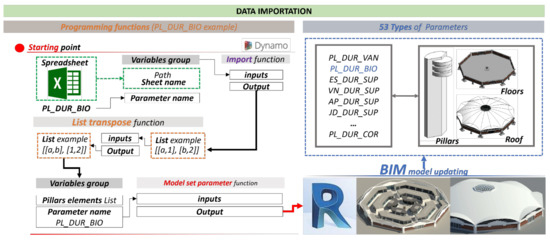
Figure 9.
Example of the Dynamo coding process to import pillar management code to 3D Model.
The process shown in Figure 10 was made with the example of PL_DUR_BIO considering it as a management parameter for pillars. In order to use the import function from the worksheet to the BIM model, a group of variables was needed. One of them is the sheet name path in a string format. The other variable needed is the parameter to be imported. In this case, PL_DUR_BIO is used. The import function provides a list as output. Such list hosts all the management parameters with names and values for each pillar. This list is a collection of sub lists. Each sub list has two items: the parameter name and the value. In order to achieve the data importation to the model, the input list of the set parameter function should have only two sub lists: one with all the parameter names and the other with all parameter values. This is done by the list transpose function. Once the list format objective is reached, it is attached with the parameter name PL_DUR_BIO as input of the model set parameter function. The output of it is the BIM model parameter updating.
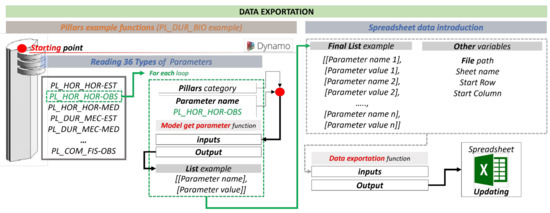
Figure 10.
Example of the Dynamo coding process to export pillar management parameter.
Likewise, the data incorporated into the 3D model after the inspections can be extracted and exported to a platform to make the corresponding decisions (Figure 10). In the figure, pillar management parameters are exported to a technical spreadsheet. The process starts with the collection of all pillars’ management parameters, which are 36. For each parameter, the parameter name, i.e., PL_HOR_HOR-OBS is provided as input for the Model get parameter function. This will provide a list composed by sub list with two items: the parameter name and the parameter value. Thanks to the loop “for each”, a complete list of all parameter’s names and values for each pillar is reached, located in Figure 10 as “Final list example”. With the cited list, other variables should be provided as input of data exportation function. Example of those variables are the spreadsheet file path, the sheet name, the starting row and the starting column. The final output of the data exportation function is the spreadsheet updating.
In this way, the damage and pathologies located during the inspection can be incorporated into the 3D model, as well as the cost of repairing these according to the four groups of families. When any of the damage is serious enough, the information can be exported to a file and a proposal can be made to correct that situation in a prioritised way. In order to show the magnitude of the Dynamo coding, Figure 11 details the whole programming developed in this investigation.
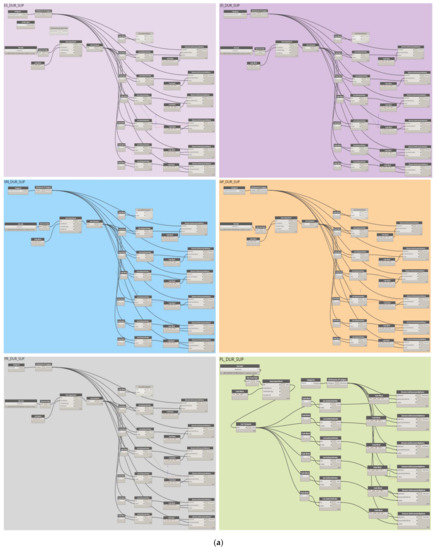
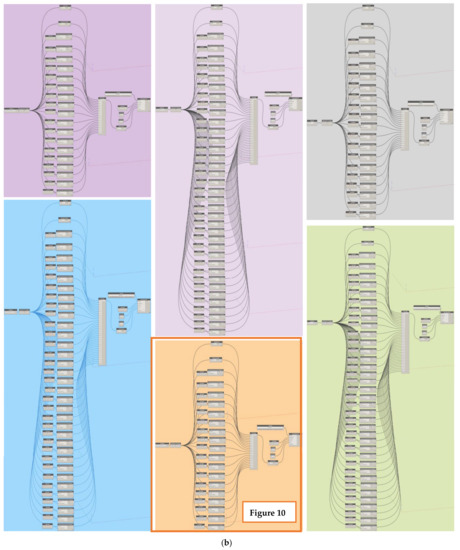
Figure 11.
Complete programming Dynamo code (a) to import to 3D Model for each element category; (b) To export the damage to file.
3.5. Phase V
Derived from the previous phase, it seeks to determine thresholds that lead to the intervention phase. When any of the damage is serious enough, proposals can be made to correct this situation in a prioritized way since all the information on the state of the infrastructure is available.
The therapy is only possible if a correct and complete database is created for each of the elements of the structure, always considering both the geometric and functional characteristics, as well as the history of damage or repairs which have been carried out by the administration and by the contractor. For this, it is essential to collect all the available information, so that the data included in the 3D model are as accurate and reliable as possible. In this way, the necessary resources for the recovery of the infrastructure can be estimated to acceptable levels, as well as identifying the optimal moment for action considering all the parameters described above such as level of damage, management process or even social, political or cultural factors.
The intervention carried out might involve a rehabilitation, restoration or adjustment of the level of maintenance applied, intensifying or even reducing it, in such a way that it is possible to increase the life cycle with the initial conditions of the infrastructure. Lastly, the creation of a platform where all the actions are stored and analysed will provide economic and time savings, as well as a history of conservation costs throughout the useful life of the structure that allows future interventions to be prioritised.
4. Discussion
This section aimed at discussing the impact of the proposed HCIM methodology in public works, taking as an example the Algeciras Market Hall. In Phase I, the first problem is derived from the lack of original structure drawings for the creation of the 3D model that allow to define exactly all the components. Some of the elements have even had to be modelled from just photographs. The use of different capture and measurement mechanisms can help to better define the 3D model, even if they involve a significant initial outlay. Within this same phase, an important lack of information on the rehabilitations carried out previously has been observed. Only the memory of the rehabilitation project carried out in 1997 was found for the Algeciras Market Hall, although there have been several interventions that have taken place.
Thus, to achieve an improved preventive conservation, it is essential to create an adequate inventory within the 3D model, including not only its physical and functional characteristics, but also a history of inspections and repairs that helps predicting how the degradation of the structure is expected to occur. In such a sense, HCIM has shown to be a powerful tool to be considered for future management of any historic constructed environment. To catalogue in Phase III the possible damages and pathologies, a methodological guide for the technical inspection of buildings has been used. However, the possibilities offered by this guide are insufficient with regard to repair and rehabilitation cultural heritage projects. For this reason, a specific damage catalogue had to be created for this project, taking as an example the one shown in Table 1. Therefore, it is, in the interest of the cultural heritage, highly desirable to create a new methodology guide specific to rehabilitations. Furthermore, transferring information between the model and the database is solved by using Dynamo as it is described in Phase III and IV, without external software support. In this way, the possibilities offered by both the database created and the 3D model can be used to carry out subsequent repair and rehabilitation work or projects. In addition, it is possible to obtain, through a cost database associated with the damage groups, the economic valuation derived from the corresponding inspection, as well as a history of the maintenance costs throughout the useful life of the structure. In this way we would reach the last challenge, Phase V [10].
5. Conclusions
The aging and deterioration of the built environment is a major problem that entails a very high annual economic outlay given the enormous heritage of infrastructure that some countries manage. This makes it necessary to improve the traditional inspection and management systems. This article presents a BIM approach to preventive conservation of public works heritage (HCIM). With this objective, HCIM has been applied to the Algeciras Market Hall, where an optimised, safe and sustainable infrastructure management has been implemented.
However, the application of BIM methodology is still complex in certain infrastructure assets and even more so in public works heritage. On the one hand, it must be considered that this implementation is only possible if a correct and complete database of each of the elements of the structure is created, considering both the geometric and functional characteristics and the history of damages and rehabilitations that have been carried out. This database must be bidirectionally connected to the BIM model. It is therefore essential to collect all available information so that the data included in the model are as accurate and reliable as possible. On the other hand, there are no working guides specialised in the conservation of public works heritage, as in the case of bridge maintenance, so it has been necessary to adapt their application to the few working guidelines that are available.
Despite all this, there are more advantages than disadvantages in the use of this methodology and it is expected to be successful in the future management of the assets of most existing infrastructure. The most important of these is the creation of a digitalised record connected to a model that is totally identical to reality, which facilitates the conservation process depending on the type of infrastructure we have.
Future work will therefore focus on improving the HCIM methodology, depending on the infrastructure typology, for preventive conservation. For this, it will be necessary to add additional features such as automated inspection using photogrammetry or laser scanning technologies and calibrated structural analysis with automated measurements of stresses and deformations.
Author Contributions
Conceptualisation, M.G.A. and A.A.A.Á.; Data curation, R.M.P. and A.G.B.; Formal analysis, Á.M.B., A.A.A.Á. and A.G.B.; Funding acquisition, M.G.A.; Investigation, Á.M.B., M.G.A., R.M.P. and A.G.B.; Methodology, Á.M.B., M.G.A. and A.A.A.Á.; Project administration, A.G.B.; Resources, A.A.A.Á.; Software, Á.M.B., R.M.P. and A.G.B.; Supervision, M.G.A. and A.A.A.Á.; Visualization, R.M.P.; Writing—original draft, Á.M.B. and R.M.P.; Writing—review and editing, M.G.A. All authors have read and agreed to the published version of the manuscript.
Funding
This research received no external funding.
Institutional Review Board Statement
Not applicable.
Informed Consent Statement
Not applicable.
Data Availability Statement
The data presented in this study are available on request from the corresponding author.
Acknowledgments
The authors gratefully acknowledge the financial support provided by the Ministry of Economy, Industry and Competitiveness of Spain by means of the Research Fund Project PID2019-108978RB-C31. They also offer their gratitude to Calle 30 for supporting the Enterprise University Chair Calle30-UPM. The authors also acknowledge the support provided by the UPM through the Educational Innovation Project IE1920.0409.
Conflicts of Interest
The authors declare no conflict of interest.
References
- Linares Jáquez, Y.M. Protocolo HBIM para la restitución histórica del patrimonio cultural y arquitectónico: Reconstrucción virtual del Foro Romano de Sagunto. Master’s Thesis, Valencia Polytechnic University, Valencia, Spain, 2019. [Google Scholar]
- Pavón, R.M.; Arcos Alvarez, A.A.; Alberti, M.G. Possibilities of BIM-FM for the Management of COVID in Public Buildings. Sustainability 2020, 12, 9974. [Google Scholar] [CrossRef]
- Lu, Q.; Chen, L.; Lee, S.; Zhao, X. Activity theory-based analysis of BIM implementation in building O&M and first response. Autom. Constr. 2018, 85, 317–332. [Google Scholar]
- Andrés, M.B. Consideraciones del Consejo de Estado sobre el contrato de concesión de obra pública en la nueva Ley de Contratos del Sector Público de 2017. Doc. Adm. 2017. [Google Scholar] [CrossRef]
- Matulionis, R.C.; Freitag, J.C. Preventive Maintenance of Buildings; Van Nostrand Reinhold: New York, NY, USA, 1991; ISBN 0-442-31866-9. [Google Scholar]
- Mora, R.; Sánchez-Aparicio, L.J.; Maté-González, M.Á.; García-Álvarez, J.; Sanchez-Aparicio, M.; Gonzalez-Aguilera, D. An historical building information modelling approach for the preventive conservation of historical constructions: Application to the Historical Library of Salamanca. Autom. Constr. 2021, 121, 103449. [Google Scholar] [CrossRef]
- Masciotta, M.G.; Morais, M.J.; Ramos, L.F.; Oliveira, D.V.; Sanchez-Aparicio, L.J.; González-Aguilera, D. A digital-based integrated methodology for the preventive conservation of cultural heritage: The experience of HeritageCare project. Int. J. Archit. Herit. 2021, 15, 844–863. [Google Scholar] [CrossRef]
- González, A. Aplicación de la Metodología BIM a la Conservación y el Mantenimiento del Patrimonio de la Obra Pública. Master’s Thesis, Universidad Politécnica de Madrid, Madrid, Spain, 2020. [Google Scholar]
- Brumana, R.; Della Torre, S.; Previtali, M.; Barazzetti, L.; Cantini, L.; Oreni, D.; Banfi, F. Generative HBIM modelling to embody complexity (LOD, LOG, LOA, LOI): Surveying, preservation, site intervention—The Basilica di Collemaggio (L’Aquila). Appl. Geomat. 2018, 10, 545–567. [Google Scholar] [CrossRef]
- Santagati, C.; Papacharalambous, D.; Sanfilippo, G.; Bakirtzis, N.; Laurini, C.; Hermon, S. HBIM approach for the knowledge and documentation of the St. John the Theologian cathedral in Nicosia (Cyprus). J. Archaeol. Sci. Rep. 2021, 36, 102804. [Google Scholar] [CrossRef]
- Moreno Bazán, Á.; Alberti, M.G.; Arcos Álvarez, A.; Trigueros, J.A. New Perspectives for BIM Usage in Transportation Infrastructure Projects. Appl. Sci. 2020, 10, 7072. [Google Scholar] [CrossRef]
- Blanco Rávena, R.; Martínez García, J.; Mozas González, B.; García Alberti, M.; Arcos Álvarez, A.A. Use of BIM methodology in the re-modelling of an existing bridge. Anales de Edificación 2019, 5, 100–106. [Google Scholar] [CrossRef]
- Moya Sala, Q.; García García, A.; Camacho-Torregrosa, F.J.; Campoy Ungria, J.M. BIM para infraestructuras de carreteras: Verificación de la normativa de diseño geométrico. Span. J. BIM 2017, 17, 10–18. [Google Scholar]
- Sánchez-Aparicio, L.J.; Masciotta, M.G.; García-Alvarez, J.; Ramos, L.F.; Oliveira, D.V.; Martín-Jiménez, J.A.; González-Aguilera, D.; Monteiro, P. Web-GIS approach to preventive conservation of heritage buildings. Autom. Constr. 2020, 118, 103304. [Google Scholar] [CrossRef]
- Menéndez, A.; Arias Hoffman, G.; Ramírez, M.L.; Vallés Morán, F.J.; Pulido, I.; León, J.; Ley, J.; Matute, L.; García, M.; Ladret, P.; et al. Guía Para la Realización de Inspecciones Principales de Obras de Paso en la Red de Carreteras del Estado; Centro de Publicaciones, Secretaría General Técnica, Ministerio de Fomento: Madrid, Spain, 2012; p. 335. [Google Scholar]
- Moreno Bazán, Á.; García Alberti, M.; Enfedaque, A.; Núñez Fernández, M.; Molina Sánchez, R. Aplication of BIM methodology to the operation and mantainance of roads. In Proceedings of the Madrid, III International Conference of Educational Innovation in Building, CINIE, Madrid, Spain, 6–8 March 2019; pp. 43–44. [Google Scholar]
- Ramos, L.F.; Masciotta, M.G.; Morais, M.J.; Azenha, M.; Ferreira, T.; Pereira, E.B.; Lourenço, P.B. HeritageCARE: Preventive conservation of built cultural heritage in the South-West Europe. In Innovative Built Heritage Models; CRC Press: Boca Raton, FL, USA, 2018; pp. 135–148. [Google Scholar]
- Cowan, H.J. A history of masonry and concrete domes in building construction. Build. Environ. 1977, 12, 1–24. [Google Scholar] [CrossRef]
- Inspección Técnica de Edificios. Guía Metodológica Para la Inspección Técnica de Edificios, País Vasco, España, 1/137. 2017. Available online: https://docplayer.es/79239455-I-t-e-inspeccion-tecnica-de-edificios-guia-metodologica-137.html (accessed on 9 December 2021).
- Randazzo, L.; Collina, M.; Ricca, M.; Barbieri, L.; Bruno, F.; Arcudi, A.; La Russa, M.F. Damage Indices and Photogrammetry for Decay Assessment of Stone-Built Cultural Heritage: The Case Study of the San Domenico Church Main Entrance Portal (South Calabria, Italy). Sustainability 2020, 12, 5198. [Google Scholar] [CrossRef]
- Jofré-Briceño, C.; Rivera, M.L.; Atencio, E.; Herrera, R.F. Implementation of facility management for port infrastructure through the use of UAVS, photogrammetry and BIM. Sensors 2021, 21, 6686. [Google Scholar] [CrossRef] [PubMed]
Publisher’s Note: MDPI stays neutral with regard to jurisdictional claims in published maps and institutional affiliations. |
© 2021 by the authors. Licensee MDPI, Basel, Switzerland. This article is an open access article distributed under the terms and conditions of the Creative Commons Attribution (CC BY) license (https://creativecommons.org/licenses/by/4.0/).